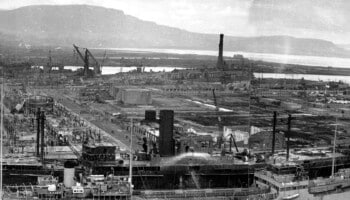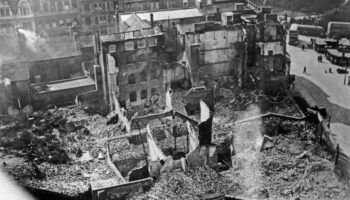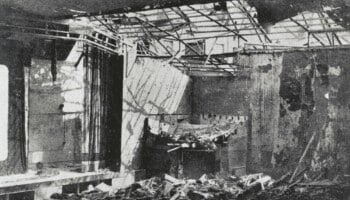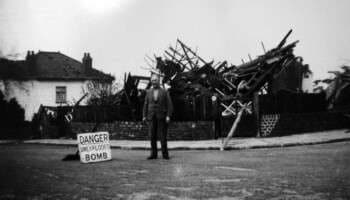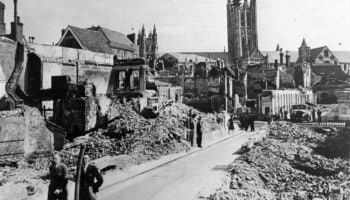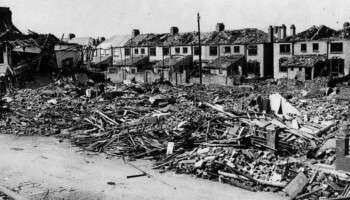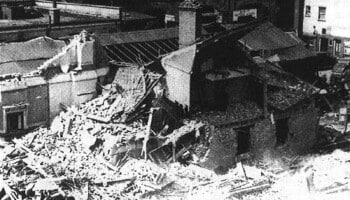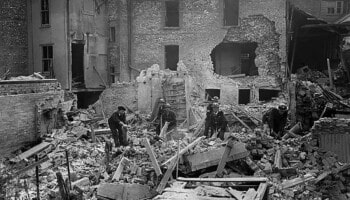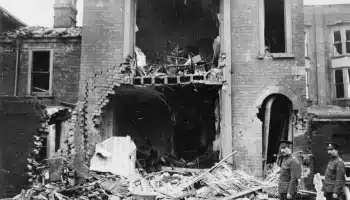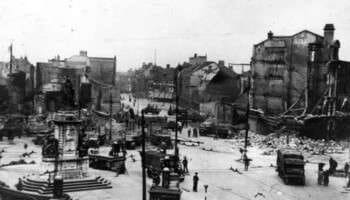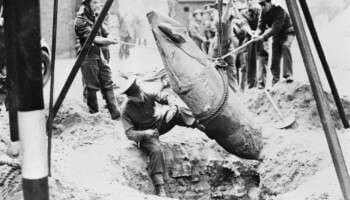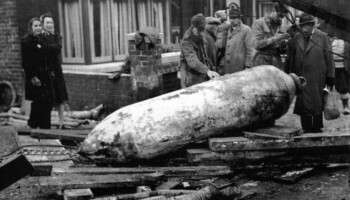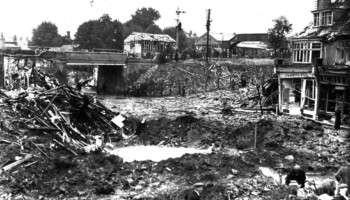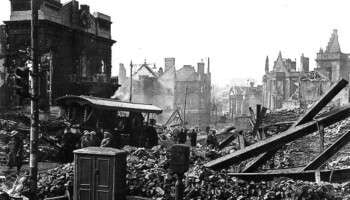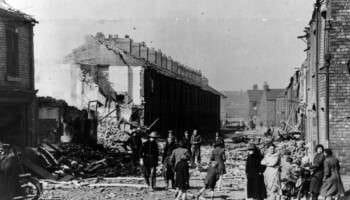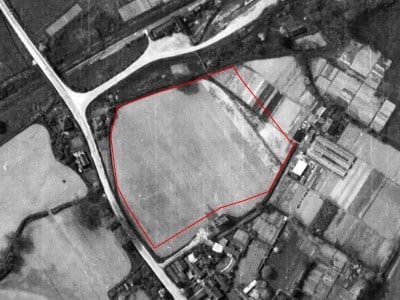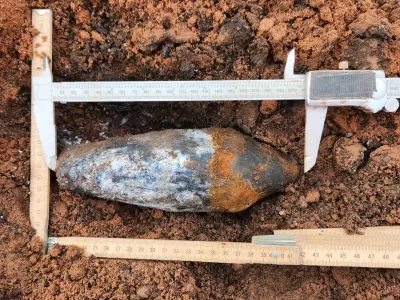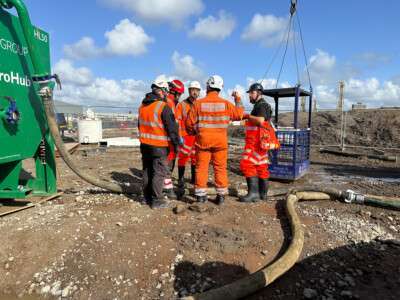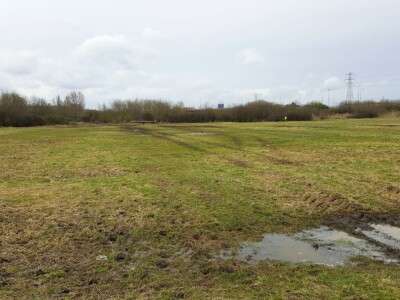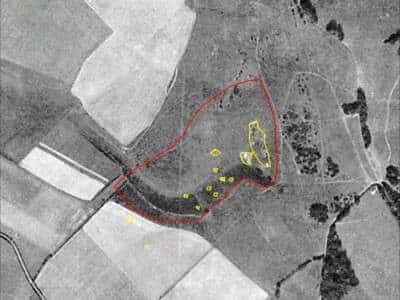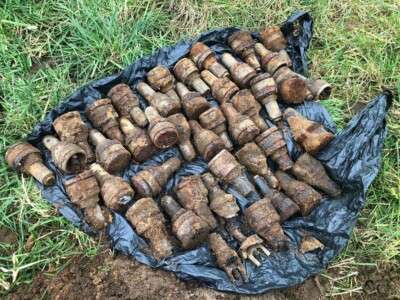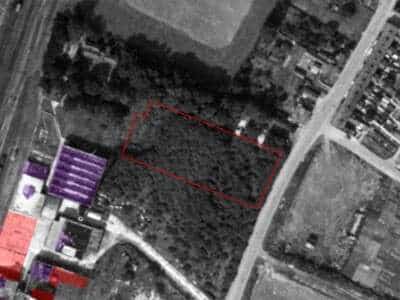What is a Detailed UXO Risk Assessment?
Stage 2 of our risk mitigation strategy: using both internal and external resources, a Detailed UXO Risk Assessment comprehensively examines the risk that UXO poses to a project. This can be for both Land or Marine sites where some sort of intrusive works are proposed – of any size or complexity.
Our detailed reports make use of extensive historical digital archives, maps, library and internet resources plus our unique and ever growing UXO geo-database – which includes data that is not available in the public domain.
Local and National Archive data is utilised, and no stone is left unturned to determine a sites history, and to ascertain as best as possible exactly what occurred on site during WWII.
The assessment will confirm a UXO risk level for your project, and if necessary, we will provide recommendations for the most appropriate risk mitigation measures to support ground works so that they proceed safely and minimise risk to all parties involved.
Why should I order a Detailed UXO Risk Assessment from 1st Line Defence?
Our Detailed UXO Risk Assessments utilise sources including local and national archives, historical and bomb census mapping, high-resolution WWII-era aerial photography, written ARP bomb incident reports and Luftwaffe target information.
All relevant data collected is presented within the report, and the content, research, risk levels and conclusions of each report are reviewed by our Quality Assurance and Senior Management Team.
Every report is meticulously produced to help you fully understand any potential risk involved and, if necessary, any risk mitigation measures required.
Contact us if you would like to see an example of a Detailed UXO Risk Assessment report.
Why choose 1st Line Defence?
1st Line Defence has the largest and most experienced full-time UXO Research Department in the country, with the capacity to produce accurate and comprehensive reports in quick timescales.
- From 2012 to 2023, 1st Line Defence produced over 4,600 Detailed UXO Risk Assessments.
- Internal geo-datasets comprising over 219,000 point sources of historical information.
- Large in-house library and digital archive comprising over 295,000 photographs, scans, maps, files and documents.
- 49% of the 644 Detailed UXO Risk Assessments produced in 2023 were assigned as ‘Low’ or ‘Low-Medium’ risk.
What do our Detailed UXO Risk Assessments consider?
The risk that UXO still remains>
It may be that there is a very viable risk of UXO contamination on a site – i.e. that unexploded bombs could have fallen on-site unnoticed during the war, or that UXO was buried by military personnel. However, what has occurred on site post-war is also an important factor in the overall risk assessment – the assessment of whether or not UXO is likely to remain in situ.
If the area has been subject to military Explosive Ordnance Clearance (EOC) tasks, there may less risk of UXO contamination remaining. Similarly, there is generally going to be little risk of UXO remaining at the location if ground works are close to the depth of post-war foundations and excavations. However, it is important to bear in mind that although post-war works on a site may have reduced the risk of UXO remaining in situ, the risk may not be completely negated.
For example, installation of a 3m deep basement will have negated the risk to that depth, but the maximum bomb penetration depth of a 500kg bomb can be as much as 12m below ground level. UXBs could therefore still remain present below that depth of post-war development – which is a particular concern if deep piling is being planned.
The risk that the site was contaminated with UXO>
This is the most important ‘first step’ for the Research Department and comprises the historical research that takes the most time during the production of our reports. In the UK, the risk from UXO comes from two principal sources: either from bombs dropped by the German military during WWI and WWII, or from items of explosive ordnance resulting from current and historic military land use (airfields, ranges, ordnance manufacturing sites, defensive positions, training areas etc.).
So the initial question is ‘could the site have been contamination with UXO in the first place’.
Read about UXO Risk from Military Related Sites Read about German Air-Delivered Ordnance
Assessing UXO Contamination Risk on Military Related Sites
For the risk of British (or ‘Allied’) UXO, we need to examine whether the site had any history of military use. It is often not obvious whether the military historically utilised land – evidence is often hard to spot or not recorded on historical mapping. Often there is simply no physical evidence remaining of previous use. This is where the wide-ranging knowledge, experience and unique datasets of 1st Line Defence come into play.
Over many years, we have built up extensive maps and databases of military land use and activity in the UK – and this is our first point of call to get an initial idea of any military history in the area. It may be that the site was on an old airfield – but this in itself is not sufficient to determine UXO risk. We would then need to research the specific history of the facility – maps, plans, diaries, record books, photographs and so on.
We need to try and ascertain who used the facility, how long for, what were they doing – where on the facility is the site located, was the site bombed, was explosive ordnance stored there, did training occur, where there aircraft crashes, how was the airfield defended and a whole host of other considerations. From this research, we can then start to consider the risk that these activities could have resulted in items of UXO contaminating the specific area where intrusive works are proposed.
The ‘house-keeping’ of historic military sites was often notoriously poor, and it was not uncommon for unwanted and unused UXO to be lost, burnt, buried or otherwise discarded. The nature of potential contamination is also an important factor to consider – from Small Arms Ammunition to Practice Bombs and Land Service Ammunition – each poses a different potential risk.
Assessing Risk of UXO Contamination from German Air-Delivered Ordnance
Again, the very first consideration is simply ‘was the site area subject to bombing in the first place’. If an area was subject to no bombing, there would be no risk of contamination from the outset. Bomb density figures can be useful here, but it is not enough to rely on these alone. It is well known that many of the UK’s towns and cities were heavily bombed – most central areas will have a ‘high’ density of bombing. But this is not sufficient to determine the risk of UXB contamination. Just because a general area was subject to a high amount of bomb strikes does not mean an individual site within that area is at ‘high’ risk. The bombing has to be researched in much more detail.
The next step is to try and ascertain where individual bombs fell, what damage they caused, what type and calibre they were, whether any unexploded bombs were recorded etc. To do this, we utilise archival material such as bomb maps, written bomb incident records, anecdotal reports, diaries, aerial imagery, historical maps, damage reports and so on. By layering up this information, it is often possible to build up quite a detailed picture of what happened to a site. By combining this bombing information with factors such as groundcover, land use and frequency of access – it is possible to make an assessment of the likelihood that bombs / unexploded bombs fell in the area.
When unexploded bombs are found on construction sites today, it is because evidence of their presence was not noted and reported at the time they were dropped. This is where groundcover, damage and access frequency are key. A 50kg German high explosive bomb (the most common dropped during WWII) could leave an entry hole just 20cm in diameter. Such evidence would likely have been noted, for example on an undamaged house, factory or roadway. However, in an area of serious damage, there is a much higher likelihood that such an entry hole could be overlooked – due to it being obscured by debris and rubble etc. Most of the recent UXB finds in London fell within areas that were subject to bomb damage during the war.
Similarly, areas where ground cover would not have been particularly conducive to spotting entry holes (such as rough, vegetated ground), or areas that received very little / regular access – would also be at an elevated risk of UXBs going unnoticed. It is these areas that can be of concern when we are assessing the risk of UXO contamination. If the historical information is good enough, it will often be possible to ‘zone’ the site into different areas of risk.
Areas where the buildings survived the war intact and undamaged, and which sustained no recorded bomb strikes might be assessed to be at ‘Low’ risk, whereas an area which was subject to very serious damage or clearance may be considered ‘Medium’ risk.
The risk of encountering UXO>
The risk of encountering UXO is linked with what is planned to occur on a site. If no intrusive works are being planned (for example if the works proposed is to conduct a building refit), there will be no risk of encountering buried UXO. If excavation is being planned down to several meters across the site, any UXO present is likely to be encountered.
The risk of initiating UXO>
UXO will not just spontaneously explode. If left buried and entirely undisturbed, an item of UXO poses little risk as some form of energy is required in order to potentially initiate UXO – for example: heat, impact and shocks/vibration. This is why construction activities such as excavation and piling can pose a significant risk of initiation.
It is often not evident from looking at an item of UXO exactly why that device failed to function as designed – but there is always a risk that it could still initiate. There have been many incidents of UXO unexpectedly initiating – either through mishandling or during construction works – especially in mainland Europe.
The consequences of encounter or initiation>
The most serious consequence of unexpected UXO detonation is the risk posed to life and limb. Secondary factors such as damage to assets and property, financial loss, reputational loss and environmental harm must also be considered. Just finding an item of UXO (or potential item of ordnance) on a construction site can result in significant delays and downtime – even if that item turns out to be inert. This is why it is always recommended to assess and manage any potential UXO risk on-site as early as possible in the project lifecycle.
UXO City Guides
The risk of encountering UXO as a result of WWII is not limited solely to London. Through a series of UXO City Guides, we explore the potential of UXO contamination at different locations across the UK.
“The programme for this project is very tight, and the Detailed UXO Risk Assessment was instructed only shortly before ground investigation was due to commence. 1st Line Defence are to be commended for their rapid response and interaction when queries were raised regarding the initial site risk level. They also prioritised the project and gave proactive and timely advice, saving out Client costs in relation to UXO support services. Furthermore, the Detailed UXO Risk Assessment has been completed and issued very quickly (yet thoroughly) again giving confidence to the design team. I would have no hesitation in using 1st Line Defence as a preferred supplier and also recommending to others.“
Director, BWB Consulting Ltd
Explore our Case Studies
Frequently Asked Questions
Browse the most commonly asked Detailed UXO Risk Assessment questions or contact us if you have a specific enquiry
The majority of UXO encountered in the UK is not actually of German origin. During WWII, over 4,000,000 hectares of UK land were in use with British and Allied armed forces. The Construction Industry Research and Information Association (CIRIA) estimates that approximately 20% of the UK's land mass has seen some form of military activity at some stage. As of 2017, the MOD’s training estate covered around 364,000 hectares. For these reasons, the only way to be sure of identifying all UXO risks on your site is to carry out a UXO Risk Assessment.
The majority of UXO encountered in the UK is not actually of German origin. During WWII, over 4,000,000 hectares of UK land were in use with British and Allied armed forces. The Construction Industry Research and Information Association (CIRIA) estimates that approximately 20% of the UK's land mass has seen some form of military activity at some stage. As of 2017, the MOD’s training estate covered around 364,000 hectares. For these reasons, the only way to be sure of identifying all UXO risks on your site is to carry out a UXO Risk Assessment.
It cannot be ruled out completely as your site could still have been bombed from opportunistic ‘tip and run’ raids that were common during WWII. Bombing overspill from raids on other major targets nearby may have also affected your site, and we would always recommend to get a UXO Risk Assessment first.
It cannot be ruled out completely as your site could still have been bombed from opportunistic ‘tip and run’ raids that were common during WWII. Bombing overspill from raids on other major targets nearby may have also affected your site, and we would always recommend to get a UXO Risk Assessment first.
Unfortunately not. They are often incomplete and should be used in conjunction with other records wherever possible. For example combining information from WWII-era aerial photography, bomb census mapping and written bomb incident records would give a more accurate indication of where a bomb fell than one of these sources alone. It is imperative that historical research for UXO Risk Assessments is thorough and that all available resources are utilised.
Unfortunately not. They are often incomplete and should be used in conjunction with other records wherever possible. For example combining information from WWII-era aerial photography, bomb census mapping and written bomb incident records would give a more accurate indication of where a bomb fell than one of these sources alone. It is imperative that historical research for UXO Risk Assessments is thorough and that all available resources are utilised.
You may be putting people at risk. Although UXO risk in the UK is generally considered ‘low probability’, it is ‘high consequence’. Health and safety legislation requires you to consider foreseeable risks such as this. Even the unexpected discovery of an item of UXO can incur expensive downtime, delays and cost overruns. Being aware of the potential risk of UXO on your site is essential. You do not have to conduct a comprehensive UXO Survey for every site, but the risk of UXO should be considered and a Preliminary or Detailed UXO Risk Assessment undertaken.
You may be putting people at risk. Although UXO risk in the UK is generally considered ‘low probability’, it is ‘high consequence’. Health and safety legislation requires you to consider foreseeable risks such as this. Even the unexpected discovery of an item of UXO can incur expensive downtime, delays and cost overruns. Being aware of the potential risk of UXO on your site is essential. You do not have to conduct a comprehensive UXO Survey for every site, but the risk of UXO should be considered and a Preliminary or Detailed UXO Risk Assessment undertaken.
The type of information we use can depend on factors such as where the site is located – but for a Detailed Risk Assessment, as a minimum we would use the following where available:
- Previous military use, location history and land use.
- Reports and records of air-delivered bombs (WWI & WWII).
- Frequency of access, damage, ground cover.
- Consideration of any mitigating factors.
- Extent and nature of proposed intrusive works.
- Local and national archives.
- Historical and bomb census and damage mapping.
- High-resolution WWII-era aerial photography.
- Written ARP bomb incident reports.
- Luftwaffe target information.
The type of information we use can depend on factors such as where the site is located – but for a Detailed Risk Assessment, as a minimum we would use the following where available:
- Previous military use, location history and land use.
- Reports and records of air-delivered bombs (WWI & WWII).
- Frequency of access, damage, ground cover.
- Consideration of any mitigating factors.
- Extent and nature of proposed intrusive works.
- Local and national archives.
- Historical and bomb census and damage mapping.
- High-resolution WWII-era aerial photography.
- Written ARP bomb incident reports.
- Luftwaffe target information.
If a Preliminary UXO Risk Assessment has identified a potential UXO risk on your site, we would recommend that a Detailed UXO Risk Assessment is commissioned – which is an in-depth desktop study which fully investigates the risk of UXO being present. If the Detailed UXO Risk Assessment has identified a threat from UXO and it has been classified as medium or high, we would recommend a risk mitigation plan is created and implemented to reduce the risk to as low as reasonably practicable (ALARP).
If a Preliminary UXO Risk Assessment has identified a potential UXO risk on your site, we would recommend that a Detailed UXO Risk Assessment is commissioned – which is an in-depth desktop study which fully investigates the risk of UXO being present. If the Detailed UXO Risk Assessment has identified a threat from UXO and it has been classified as medium or high, we would recommend a risk mitigation plan is created and implemented to reduce the risk to as low as reasonably practicable (ALARP).
Generally, a site visit is not required but for larger developments or complex sites we do sometimes arrange a visit, especially if it will assist with the UXO risk level decision making process.
It is essential that site workers and ground personnel undertaking intrusive works on your site are safe – and in the UK, this should include consideration of potential risk of encountering buried UXO. The best way to ascertain whether or not there is a potential risk is to commission a Detailed UXO Risk Assessment, which will examine the history of your site in detail and will let you know whether or not anything needs to be done to mitigate risk.
A Detailed UXO Risk Assessment will confirm a UXO risk level for your site, normally this is either ‘Negligible’, ‘Low’, ‘Medium’ or ‘High’. We consider the risk level of your site, it’s location, the proposed scope of intrusive ground works and if required – we will provide a risk mitigation plan and recommendations for any risk mitigation services to reduce the risk to as low as reasonably practicable (ALARP).
Usually, the main pieces of information we require includes:
- Full site address including postcode.
- A detailed map / plan of the site with the boundary clearly highlighted, preferably using a ‘red line’.
- Information about any proposed intrusive ground works – for example boreholes, piling, trial pits and strip foundations etc.
- Geotechnical information / borehole logs – if available.
To place an order for a Detailed UXO Risk Assessment, you can contact us on +44 (0) 1992 245020 or info@1stlinedefence.co.uk or use our contact form and a member of the team will get in touch to assist with your enquiry.
Production time for our Detailed UXO Risk Assessments is around 5 to 7 working days (once research has started) and on average take between 5 and 10 or more days to complete – but can take longer if you have a particularly large or complex site. If you need your Detailed UXO Risk Assessment sooner, make sure that you mention this when placing your order and we will try our best to accommodate your request.
To get an accurate quote for a Detailed UXO Risk Assessment you are advised to contact us so that we can gather more information about the site being investigated. As a general guide, a ‘standard’ Detailed UXO Risk Assessment will cost £950, and the cost varies depending on the size and complexity of the site. However, we aim not to be beaten on price, so if you get a more competitive quote – let us know and we will always do our best to match or beat it. Please note: if you have already purchased a Preliminary UXO Risk Assessment, the cost will be deducted from the total cost of the Detailed UXO Risk Assessment.
Need more information about our Detailed UXO Risk Assessments?
Contact us and we’ll guide you through the process for choosing the most appropriate UXO Risk Assessment for your project.
Call: +44 (0) 1992 245020 or Email: info@1stlinedefence.co.uk
